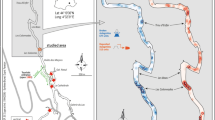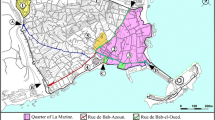Abstract
Geological heritage sites are of great importance both for better understanding of the formation of the earth and for transferring its memory to future generations. People’s curiosity to access this information leads to tourism activity, in which caves constitute a significant place as sources of geotouristic attractions. In the case of Turkey, caves can also be considered as the major source of tourist attractions and thus economic gain providers for local communities. Focusing on the contribution of tourism to the economy, most local authorities allow tourism activity for the caves without adequate research. This leads to the construction of buildings for the needs of visitors and the installation of walking pathways, ladders, and luminaires inside the caves, which are in most cases harmful to cave ecosystems. Located on the Mediterranean coastline of Turkey, Gilindire Cave presents such a case. Unlike other caves in Turkey, it is among three caves that were found to occur in the Cambrian limestone caves literature. Thus, any data to be detected in this environment is of scientific importance. However, service buildings constructed in the upper elevation of the cave and visitor stairs and luminaires installed in the interior constitute major threats to accessing this valuable information. In this context, the study aims to examine the caves in the scope of geotourism and tourism-led constructions through the example of Gilindire Cave. As a result, the study underpins the importance of diligent investigation of cave ecosystems prior to any tourism-led activity and principles for the service structures to be built in such geoheritage sites.








Similar content being viewed by others
References
Arpacı Ö, Zengin B, ve Batman O (2012) Karaman’ın Mağara Turizmi Potansiyeli ve Turizm Açısından Kullanılabilirliği. K.M.Ü. Sosyal ve Ekonomik Araştırmalar Dergisi 14(23):59–64
Baris O. (2009) Erzurum Ilindeki Magaralarda Damlatasi Olusumunda Etkili Bakterilerin İzolasyonu, Karakterizasyonu Ve Tanısı , Ataturk Universitesi Doktora Tezi
Barton, H.A. 2006. Introduction to cave microbiology: a review for the non-specialist
Burstyn Y, Martrat B, Lopez J, Iriarte E, Jacobson MJ, Lone MA, Deininger M (2019) Speleothems from the Middle East: An example of water limited environments in the SISAL database. Quaternary 2(2):16
Carolin SA, Ersek V, Roberts WHG, Walker RT, Henderson GM (2019) Drying in the Middle East during Northern Hemisphere cold events of the early glacial period. Geophysical Res Let 46:14003–14010. https://doi.org/10.1029/2019GL084365
Cavicchioli R, Charlton T, Ertan H, Omar SM, Siddiqui KS, Williams TJ (2011) Biotechnological uses of enzymes from psychrophiles. Microb Biotechnol 4(4):449–460
Engel, Annette. (2010). Microbial diversity of cave ecosystems. https://doi.org/10.1007/978-90-481-9204-5_10
Erdoğan, S., Ergeneli, H.S. ve Delibaş, M. (unpublished). Gilindire Mağarası Yönetim Planı. Orman ve Su İşleri Bakanlığı, Doğa Koruma ve Milli Parklar Genel Müdürlüğü. Ankara
Frumkin A (2000) Paleoclimate and vegetation of the last glacial cycles in Jerusalem from a speleothem record. Glob Biogeochem Cycles 14(3):863–870
Gerday C, Aittaleb M, Bentahir M, Chessa JP, Claverie P, Collins T, D’Amico S, Dumont J, Garsoux G, Georlette D, Hoyoux A, Lonhienne T, Meuwis MA, Feller G (2000) Cold-adapted enzymes: from fundamentals to biotechnology. Trends Biotechnol 18(3):103–107
Külekçi, E.A. Ve Sezen, I. (2018). Bir Ekoturizm Aktivitesi Olarak Mağara Turizmi; Erzurum İli Elmalı Mağarası Örneği. Süleyman Demirel Üniversitesi Mimarlık Fakültesi E-Dergisi, 3(1),66–75.http://dergipark.gov.tr/download/issue-full-file/35619 (Erişim tarihi: 8 Eylül 2018)
Li L, Victoria JG, Wang C, Jones M, Fellers GM, Kunz TH, Delwart E (2010) Bat guano virome: predominance of dietary viruses from insects and plants plus novel mammalian viruses. J Virol 84(14):6955–6965
Nazik, L., Derici, Ş., Kutlay, H., Törk, K., Özel, E., Mengi, H., Aksoy, B., Güner, İ. N., Ve Acar, C. (2001). Deniz kenarında bulunan polijenik bir mağara: Gilindire Mağarası (Aydıncık, İçel). 54. Türkiye Jeoloji Kurultayı Bildiri No: 54-31, 7-10 Mayıs 2001, Ankara: Türkiye Jeoloji Kurumu
Öcal T, ve Özcan F (2013) Çamlık Mağaraları ve Turizm Potansiyeli. Marmara Coğrafya Dergisi 28(7):423–433
Onaga, L. 2001. Cashing in on nature’s pharmacy: bioprospecting and protection of biodiversity could go hand in hand. EMBO Rep. 2(4): 263–5. European Molecular Biology Organization. Available from http://www.ncbi.nlm.nih.gov/pubmed/11306540 []
Özşahin E, Kaymaz Ç (2014) Gilindire (Aynaligöl) Mağarasi’nin Turizm Potansiyeli (Aydincik, Mersin). Doğu Coğrafya Dergisi 19(31):145–166
Özşahin E, Kaymaz Ç (2015) Gilindire (Aynalıgöl) Mağarası Tabiat Anıtının Jeoçeşitlilik Değerlendirmesi. Aydıncık, Mersin
Roche B, Guégan JF (2011) Ecosystem dynamics, biological diversity and emerging infectious diseases. C R Biol 334(3–6):385–392
Rowe PJ, Mason JE, Andrews JE, Marca AD, Thomas L, van Calsteren P, Jex CN, Vonhof HB, al-Omari S (2012) Speleothem isotopic evidence of winter rainfall variability in Northeast Turkey between 77 and 6 ka. Quat Sci Rev 45:60–72. https://doi.org/10.1016/j.quascirev.2012.04.013
Russell NJ (1998) Molecular adaptations in psychrophilic bacteria: potential for biotechnological applications. Adv Biochem Eng Biotechnol 61:1–21
Stockhecke, M., Timmermann, A., Kipfer, R., Haug, G. H., Kwiecien, O., Friedrich, T., Menviel L., Litt T., Pickarski N., Anselmetti F. S. (2016). Millennial to orbital-scale variations of drought intensity in the Eastern Mediterranean. Quat Sci Rev 2016; 133, 77–95. https://doi.org/10.1016/j.quascirev.2015.12.016
Author information
Authors and Affiliations
Corresponding author
Rights and permissions
About this article
Cite this article
Aydın, R., Yüceer, H. Impacts of Tourism-Led Constructions on Geoheritage Sites: the Case of Gilindire Cave. Geoheritage 12, 42 (2020). https://doi.org/10.1007/s12371-020-00463-6
Received:
Accepted:
Published:
DOI: https://doi.org/10.1007/s12371-020-00463-6




